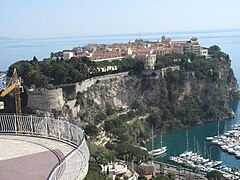Monaco City
Monaco City | |
|---|---|
Ward | |
 View of Monaco City | |
| Nickname(s): The Rock Monaco-Ville | |
 Location in Monaco | |
| Coordinates: 43°43′51.24″N 7°25′26.76″E / 43.7309000°N 7.4241000°E | |
| Country | |
| Area | |
| • Land | 19.6491 ha (48.5540 acres) |
| Population (2008) | |
• Total | 975 |
| • Density | 4,962/km2 (12,850/sq mi) |

Monaco City (French: Monaco-Ville [mɔnakɔ vil]; Monégasque: Mùnegu Autu)[1] is the southcentral ward in the Principality of Monaco.[2] Located on a headland that extends into the Mediterranean Sea,[3] it is nicknamed The Rock (French: Le Rocher; Monégasque: A Roca). The name "Monaco City" is misleading: it is not itself a city, but a historical and statistical district.[4][5] It holds most of the country's political and judicial institutions: the Prince's Palace, the town hall, the government, the National Council (parliament of Monaco), the Municipal Council, the courts and a prison (hanging on The Rock).[6]
Geography
[edit]Monaco City is one of the four traditional quarters (French: quartiers) of Monaco; the others are La Condamine, Monte Carlo, and Fontvieille. It is located at 43°43′51″N 7°25′26″E / 43.73083°N 7.42389°E and has an estimated population of 975. It has 19.64 hectares of surface and is located between the districts of Fontvieille and La Condamine.
History
[edit]Monaco Ville was originally called in Greek Monoikos, after the temple of Hercules Monoikos, located in a Phocaean colony of the 6th century BCE. During its history, Monoikos changed hands numerous times. It became Monaco in the Middle Ages. Some of the city walls and original structures still remain.
It was here that the Phocaeans of Massalia (now Marseille) founded the colony of Monoïkos in the 6th century BC. Monoikos was associated with Hercules, who was worshipped as Hercules Monoecus. According to the works of Hercules, but also according to Diodorus of Sicily and Strabo, the Greeks and the Ligurians reported that Hercules had passed through the region.
On 10 June 1215, a detachment of Ghibellines led by Fulco del Cassello began the construction of a fortress on the rock of Monaco in order to make it a strategic military position and a means of controlling the area.
They also established dwellings at the base of the Rock to support the garrisons. To attract the inhabitants of Genoa and the surrounding towns, they offered land and exempted newcomers from taxes.
On January 8, 1297, François Grimaldi, descendant of Otto Canella, consul of Genoa in 1133, took over the fortress. Although he had a small army, he disguised himself as a Franciscan friar to enter, before opening the gates to his soldiers. This episode gave rise to his nickname, Malizia ("malice"). This is why today the arms of Monaco bear two Franciscans armed with a sword.
Landmarks
[edit]Despite being located in the middle of the City of Monaco, the world's most densely populated urban center, Monaco City remains a medieval village at heart, made up almost entirely of quiet pedestrian streets and marked by virtual silence after sundown. Though innumerable people visit Monaco City and the palace square, only local vehicles are allowed up to the Rock, and gasoline-powered motorcycles are prohibited after 10 p.m.
- Prince's Palace of Monaco. The colorful changing of the guard occurs every day outside the Palais at 11:55 a.m.
- Cathedral of Our Lady Immaculate (French: Cathédrale de Monaco), a Romanesque-Byzantine Catholic church that contains the remains of many members of Monaco's ruling family.
- The Oceanographic Museum, established by Albert I, Prince of Monaco in 1910.
- Chapel of Mercy, built in 1639, one of the oldest buildings in the principality. It is famous for being the starting point of a torchlit religious procession by local residents that takes place on the eve of Good Friday each year.
- St Martin Gardens, a small park of rocky paths that cling to the rock.
- Museum of the Chapel of Visitation, a 17th-century Roman Catholic chapel and art museum.
- Fort Antoine Theatre, an amphitheater at the bottom of the rock.[7]
Notable residents
[edit]- Beatrice Borromeo, Italian journalist and socialite
- Andrea Casiraghi, Monégasque royal
- Charlotte Casiraghi, Monégasque royal
- Pierre Casiraghi, Monégasque royal
- Stefano Casiraghi, Italian socialite
- Tatiana Casiraghi, Colombian-American socialite
- Ghislaine Dommanget, French actress, Princess of Monaco
- Daniel Ducruet, Carabinier in the Compagnie des Carabiniers du Prince
- Louis Ducruet, Monégasque royal
- Gad Elmaleh, Moroccan actor
- Philippe Gilbert, Belgian cyclist
- Camille Gottlieb, Monégasque royal
- Albert Grimaldi, Prince of Monaco
- Caroline Grimaldi, Princess of Hanover, Princess of Monaco
- Gabriella Grimaldi, Princess of Monaco
- Jacques Grimaldi, Prince of Monaco
- Rainier Grimaldi, Prince of Monaco
- Stéphanie Grimaldi, Princess of Monaco
- Alexandra Hanover, Princess of Hanover
- Grace Kelly, American actress, Princess of Monaco
- Charlene Wittstock, South African swimmer, Princess of Monaco
- Charles Leclerc, Monégasque Formula 1 driver
Gallery
[edit]- A street in Monaco City
- The Rock of Monaco from Monaco's exotic garden
- The Prince's Palace of Monaco
- View of Monaco City from the east
See also
[edit]References
[edit]- ^ King, David C. (2008). Monaco. Marshall Cavendish. ISBN 978-0-7614-2567-0.
- ^ Eccardt, Thomas M. (2005). Secrets of the Seven Smallest States of Europe: Andorra, Liechtenstein, Luxembourg, Malta, Monaco, San Marino, and Vatican City. Hippocrene Books. ISBN 978-0-7818-1032-6.
- ^ Steves, Rick (2019-10-29). Rick Steves Mediterranean Cruise Ports. Avalon Publishing. ISBN 978-1-64171-094-7.
- ^ "United-Nations data, country profile". Retrieved 29 October 2013.
- ^ "Constitution of Monaco (art. 78): The territory of the Principality forms a single commune.". Retrieved 29 October 2013.
- ^ Mundo, Instituto del Tercer (2008). Guia del Mundo 2009 (in Spanish). IEPALA Editorial. ISBN 978-84-675-3225-8.
- ^ "Fort Antoine". Visit Monaco - Fort Antoine. Visit Monaco. Retrieved 27 June 2014.
External links
[edit] Media related to Monaco-Ville at Wikimedia Commons
Media related to Monaco-Ville at Wikimedia Commons


 French
French Deutsch
Deutsch



